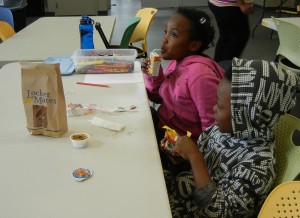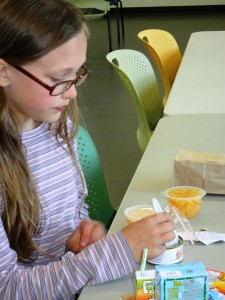The transformation of libraries has people exclaiming “I didn’t know libraries did that!” Each of the five Anchorage Public Library locations offers programs that add to the quality of neighborhood life. This article by Mountain View Library Director Elizabeth Moreau Nicolai and Youth Librarian Mary-Kate Fowee is an example of meeting local needs and expanding minds at the same time.
Michael is crafting. The staff of the Mountain View Library is stunned. Michael does NOT do crafts and is indignant in the way only a 13-year-old can muster at the mere suggestion that he should try.
“Crafts are for girls,” he reminds library staff almost daily when he comes into the “Lunch and Play” program; today doubly so: we’re making origami flowers. His lack of interest in the activity doesn’t stop him from attending the program, though. He’s a hungry kid and we’re giving away food. He’ll come in for that. But only that, he insists.

After just 20 minutes of gnawing on turkey jerky watching everyone else have fun, he begrudgingly decides to try. By the end of the program, he’s buried in an origami book, comparing his flower to everyone else’s and declaring his new skills “superior.”
Michael may not know it, but he embodies many of the reasons why providing food service for children works so well for the Mountain View Library. Like Michael, many young residents in the area have food needs that are not being fully met. According to the Anchorage School district, a full 100 percent of Clark Middle School is considered to be economically disadvantaged (the district average is 45 percent) and 99.9 percent of students attending the school receive free or reduced meals.
Clark teachers report students pocketing food from Friday’s lunch to tide them through the weekend. Area students often lose weight during the summer months when there are fewer services available. Many students bear the weight of ensuring their siblings are cared for and fed.
With a mere 200 yards separating the front doors of the library and the school, meeting these students’ needs has become an integral part of library programming. With such close proximity, it’s no surprise that the library regularly is packed with students in the evenings. Teens crowd around friends at the computer stations, pile onto benches and chairs, and finally the floor when other options are exhausted. When the program room opens up they clamor over in droves.

Initially, the MV Library struggled to create programs that attracted the interest of teens that regularly filled the library. Despite hundreds of kids congregating within or around the building, only a dozen or so went into the program room while even fewer spent any meaningful time participating.
Thanks to a partnership with the Food Bank of Alaska which began in the summer of 2011, the MV library started serving full meals during some programs to patrons under the age of 18. Immediately attendance tripled, and has kept increasing steadily. This year, the library regularly served between 80 and 140 meals per program.
The true genius of the food program is that it creates an environment in which participation is optional, not the “all or nothing” feel that crops up in traditional programming structure. Many teens come in just for the food, with no initial interest in joining in our planned activities, but like Michael, they are drawn into an activity as they finish up their meals, and start engaging with the staff.
Before the food service, we occasionally provided minimal snacks, such as granola bars. Kids would grab the snack and scarf it down while heading back out the door.
Food service changed the library dynamic. While meals brought in even more youth, they were lured into the community room which freed up space in the library proper for more traditional library services.
Now, even those not actively involved in the craft or game show a certain ownership in programs. They’ve begun to clean up after themselves with minimal prompting, or they cheer on friends participating in a Wii dance-off. A person checks out a Ukulele (another non-traditional program) to play. Two people singing quickly become 10 people singing with two dozen watching and clapping along.
Joseph was one of the first regular attendees in 2011 to embrace food service. Dangerously scrawny, the almost sixth grader came in daily, often in the same unwashed clothes as the day before, ravenously hungry and always smiling.
After a few weeks, he brought in two younger siblings. Soon they were joined by some next door neighbors. Before the end of the summer, Joseph was walking six to eight kids from his neighborhood for their lunch every day. He convinced the kids’ parents to get them library cards, signed himself and all his young charges up for summer reading, and devoured books as voraciously as his favorite applesauce cups.
Two years later, Joseph is starting to think about high school. He’s grown over a foot and added bulk to his frame, but most importantly, he’s learned to navigate social services available to him and his family. Perhaps this is not a normal middle school skill, but it is an all too vital one in many neighborhoods. While no longer a daily attendee of summer food service, he still drops by, sometimes with a youth in tow, for lunch, to check out a book and a chat with his friends on library staff.
That is enough of a win for Mountain View staff. We sometimes call our unorthodox approach “food for mind and body”: it is hard to convince a child with a hungry stomach to sit still and read. When survival is a struggle, education and reading can fall by the wayside. By coupling food with learning opportunities, both the youth and our library flourish simultaneously.
Anchorage Public Library provides resources to enrich the lives and empower the future of our diverse community, while preserving the past for generations to come.




